연기 흡인과 흡입 화상, Smoke inhalation and inhalation burn
- 화재가 난 장소에 있던 사람은 화재로 생긴 뜨거운 연기, 일산화탄소, 유독성 가스 등을 호흡할 수 있다.
- 이때 산소부족으로 질식될 수도 있고, 일산화탄소에 중독 될 수 있고, 화재에서 나온 열기로 피부나 기도 점막 등에 화상을 입을 수 있다.
- 정도가 심하면 질식, 사망 할 수 있다.
- 다세대 주택이나 밀집 상가 건물 등에 화재가 나서 주택이 탈 때 생긴 뜨거운 공기, 산소의 농도가 낮은 연기나 공기를 마실 때 질식될 수 있고 기도 점막층이 심하게 델 수 있다.
- 옷, 가구, 카펫, 또는 화학물질 등이 화재로 탈 때 생긴 유독성 가스를 호흡해서 그 유독성 가스로 중독 될 수 있다.
- 또 뜨거운 연기를 호흡해서 비강, 인두, 후두, 기관, 기관지 점막층과 폐포가 화상을 입을 수 있다. 이때, 기도가 붓고 화상 폐렴이나 화학물질 폐렴이 생길 수 있다.
- 화상 폐렴이 생기면 기도가 붓고 좁아지고 가래가 분비되고 기침을 하면서 숨이 차고 호흡곤란이 생길 수 있다.
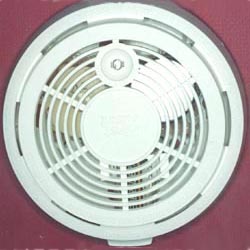
사진 348. 화재경보기를 집안에 설치하고, 여행갈 때 비상용으로 가지고 다닐 수 있다.
Copyright ⓒ 2011 John Sangwon Lee, MD., FAAP

사진 349. 평소에 소화기를 집안에 준비하고, 수시로 점검하고 쓰는 법도 알아둔다.
Copyright ⓒ 2011 John Sangwon Lee, MD., FAAP
연기 흡인과 흡입 화상의 증상 징후
- 화재가 난 장소에서 뜨거운 연기를 얼마나 오랫동안 흡입했는지, 화재로 유독성 가스가 얼마나 많이 생겼는지, 그런 유독성 가스를 얼마나 오랫동안 얼마나 많이 흡입했는지, 피부와 점막층 등의 화상의 정도, 기도 등에 생긴 화상이 어느 정도인지 등에 따라 증상 징후가 다르다.
- 화재가 난 장소에 있었던 환아가 구조된 직후 바로 기침을 별로 하지 않고 거의 정상적으로 호흡하다가도 그 후 불과 몇 시간 후 심하게 기침하면서 몹시 가쁘게 숨 쉬면서 호흡곤란이 생길 수 있다.
- 뜨거운 연기와 유독성 가스 등을 흡입하면 기도와 폐에 화상이 생길 수 있고 중독 손상 될 수 있고,
- 심하면 전신 청색증이 생기고 폐가 붓고 폐에 출혈이 생길 수 있고 사망할 수 있다.
- 특히, 플라스틱 물질이나 다른 종류의 화학물질이 화재로 탈 때 생긴 유독성 가스를 호흡하면 순식간에 질식될 수 있고 사망할 수 있다.
- 또 유독성 가스의 종류에 따라 기도 점막층과 폐가 손상되는 정도가 다르다.
- 화재가 났을 때 일산화탄소 농도가 높은 공기를 호흡하면 기도 점막층이나 폐가 손상되지 않아도 일산화탄소 중독으로 사망할 수 있다.
연기 흡입과 흡입 화상의 치료
- 화재가 났던 장소에 있었던 사람들에게 피부와 점막층 화상, 독성 가스를 흡입해서 생긴 독성 가스 중독, 일산화탄소 중독 등이 생길 수 있다.
- 나이, 화상의 크기와 정도, 유독성 가스 중독 및, 또는 일산화탄소 중독의 정도에 따라 치료한다.
화재로 연기를 호흡했을 때의 일반적인 치료법
- 우선 화재가 난 장소에서 안전한 장소로 환아를 빨리 옮긴다.
- 의료 구급대원이나 병원 응급실이나 단골 소아청소년과 의사, 또는 소방서에 긴급 전화치료를 받고 그들의 지시를 따라 현장에서 응급치료를 시작한다.
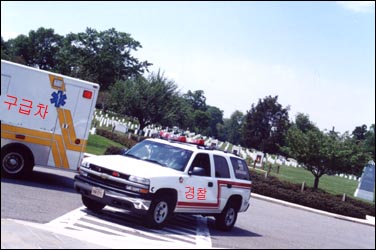
사진 350. 필요에 따라 구급대원과 앰뷸런스(구급차)를 부른다.
Copyright ⓒ 2011 John Sangwon Lee, MD., FAAP
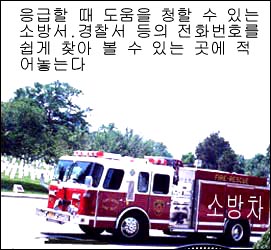
사진 351. 필요에 따라 소방차를 부른다.
Copyright ⓒ 2011 John Sangwon Lee, MD., FAAP
- 화재가 난 장소에 있던 환아의 피부에 화상이 생기지 않았어도 그 환아는 뜨거운 연기, 유독성 가스, 일산화탄소 등을 호흡했다고 가정하고 호흡기 화상, 일산화탄소 중독, 독가스 중독에 관한 치료를 적절히 시작해야 한다.
- 다시 설명하면, 겉으로 보기에 화재로 화상을 입지 않고 유독성 가스 중독의 증상 징후가 없어도 의사에게 즉시 문의해서 적절한 치료를 받는다(화상 참조).
- 화재가 났을 때 뜨거운 연기나 유독성 가스 등을 흡입한 환아를 화재가 난 바로 후 진찰할 때 아무 이상이 없고, 아무렇지 않을 수 있다. 그러나 그 후 몇 시간이 지난 후부터 약 24시간 이내 심한 화상 폐렴의 증상 징후가 나타날 수 있다.
- 특히 화재로 얼굴이나 목 부위 피부 화상을 입은 아이의 대부분은 뜨거운 연기를 호흡했을 가능성이 많고 기도 점막층에 화상을 입었을 가능성이 많다. 그런 이유로 그에 따른 적절한 치료를 해야 한다.
- 후두가 많이 데었을 때는 후두가 붓고 가래가 나오고 목이 금방 쉴 수 있다. 이때 후두 기도 부분이 빨리 막혀 사망할 수 있다.
- 화재로 기도 점막층이 손상되고 호흡곤란이 심하게 생길 때는 기관 절개수술 임시 숨구멍을 기관에 만들어 그 임시 숨구멍에 넣은 기관을 통해 숨을 쉬게 하기도 한다.
- 이런저런 이유로 화재가 난 장소에서 뜨거운 연기를 마신 환아가 목이 쉬거나 호흡곤란을 일으킬 때는 가까운 병원 응급실로 급히 데리고 가 적절한 치료를 받아야 한다.
- 화학섬유로 만든 옷에 불이 쉽게 붙어 화상을 입을 수 있다.
- 입은 옷에 불이 붙으면 불붙은 쪽을 방바닥이나 흙바닥에 대고 눕게 하거나 뒹굴게 해서 옷에 붙은 불을 끄든지 물을 끼얹든지, 젖은 담요 등으로 타는 옷을 덮든지 소화기를 이용해서 불을 끈다.
- 타다 남은 옷을 가위나 칼로 잘라 벗긴다.
- 피부 화상을 입은 바로 후에 얼음물 주머니나 찬물 주머니로 화상에 찬찜질을 하든지, 화상 입은 신체 부위를 얼음물 속에 잠시 동안 담그면 덜 아프고 덜 붓는다.
- 화상의 정도에 따라 의료 구급대원이나 병원 응급실, 또는 단골 소아청소년과 의사에게 전화해서 그들의 지시에 따라 병원 응급실로 빨리 데리고 가야 한다.
- 호흡기와 피부에 생긴 화상의 정도, 유독성 가스 중독의 정도에 따라 치료하면서 필요에 따라 항생제, 파상풍 백신 예방접종, 수혈, 전해질용액 주사, 산소호흡, 심폐 소생술, 코르티코스테로이드제, 진통제 등으로 치료한다.
연기 흡입과 흡입 화상의 예방
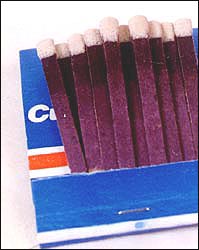
사진 352. 성냥갑
어린이들의 손에 닿지 않게 성냥을 잘 보관한다.
Copyright ⓒ 2011 John Sangwon Lee, MD., FAAP
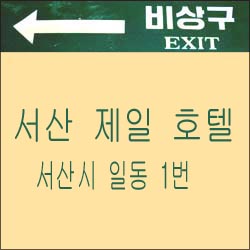
사진 353. 비상구.
화제나 응급한 경우를 대비해서 대피할 비상구가 어디에 있는지 미리 알아놓는다.
Copyright ⓒ 2011 John Sangwon Lee, MD., FAAP
- 영유아들이 성냥이나 라이터 등 발화성 물질을 가지고 불장난하면서 놀지 않도록 주의하고 발화성 물질을 안전한 장소에 보관한다.
- 집안에서 화재가 났다고 가정하고 화재가 날 때 유아들이나 학령기, 사춘기 아이들이 안전하게 대피하는 방법을 평소에 소아청소년 자녀들에게 훈련시켜야 한다.
- 호텔이나 낯선 곳에 투숙할 때 화재가 나면 대피하는 방법을 미리 알아보라고 교육시킨다.
- 잠옷이나 평소에 입는 옷은 불이 잘 붙지 않고 잘 타지 않는 것으로 선택한다.
- 담뱃불, 성냥불, 라이터 불로 화재가 잘 난다.
- 특히 침실에서 담배를 절대로 피지 말아야 한다.
- 부엌에서 뜨거운 냄비 등을 스토브에서 옮길 때 쓰는 장갑 등은 불이 붙지 않는 재료로 만들어야 한다.
- 집안에 화재경보기를 설치해 화재가 날 때는 불난 장소에서 안전한 장소로 빨리 피해 화상을 입지 않게 예방교육을 시키고 실제로 주기적으로 재훈련시킨다.
- 불이 날 때 빨리 끌 수 있는 소화기나 스프링클러 장치도 고려해 본다.
- 환자 입원실은 화제가 발생했을 때 독성 가스가 발생될 수 있는 건축 자재를 이용해 건축해서는 안된다.
Smoke inhalation and inhalation burn
• Persons in the area of the fire may breathe hot smoke, carbon monoxide, and toxic gases from the fire.
• At this time, you may suffocate due to lack of oxygen, you may be poisoned with carbon monoxide, and you may burn your skin or airway mucosa from the heat from the fire.
• In severe cases, suffocation or death may occur.
• Inhalation of hot air or low oxygen concentration of smoke or air produced when a house is burned in a fire in a multi-family house or a densely populated building can cause suffocation and severe burns to the airway mucosa.
• When clothes, furniture, carpets, or chemicals burn in a fire, you can inhale and become poisoned with the toxic gas.
• Breathing hot smoke can also burn the nasal cavity, pharynx, larynx, trachea, bronchial mucosa, and alveoli. At this time, the airways may swell and burn pneumonia or chemical pneumonia may develop.
• Burn pneumonia can cause swelling and narrowing of the airways, secretion of sputum, shortness of breath while coughing, and difficulty breathing.

Photo 348. You can install a fire alarm in the house and take it with you for emergencies when traveling. Copyright ⓒ 2011 John Sangwon Lee, MD., FAAP

Photo 349. Prepare a fire extinguisher at home, check it frequently, and learn how to use it. Copyright ⓒ 2011 John Sangwon Lee, MD., FAAP
Symptoms, Signs of smoke inhalation and inhalation burns
• How long have you inhaled hot smoke in the area of the fire, how many toxic gases have been produced in the fire, how long and how many of those toxic gases have been inhaled, the degree of burns to the skin and mucous membranes, and how many burns have occurred in the respiratory tract, etc. Symptoms vary depending on cognition.
• Immediately after a child who was in a fire area is rescued, he or she does not cough much and breathes almost normally, but only a few hours later, he or she coughs heavily and breathes very hard, causing shortness of breath.
• Inhalation of hot smoke and toxic gases may cause burns to the respiratory tract and lungs, poisoning damage,
• In severe cases, systemic cyanosis may occur, the lungs may swell, the lungs may bleed, and death may occur.
• Breathing in toxic fumes, especially when plastic materials or other types of chemicals burn in a fire, can cause instant suffocation and death.
• In addition, the degree of damage to the airway mucosal layer and the lungs differs depending on the type of toxic gas.
• In a fire, breathing air with a high concentration of carbon monoxide can cause death from carbon monoxide poisoning without damaging the mucous membranes of the airways or lungs.
Treatment of smoke inhalation and inhalation burns
• People who were in the area of the fire may have skin and mucous membrane burns, toxic gas poisoning caused by inhaling toxic gases, and carbon monoxide poisoning. • Treatment depends on age, size and severity of burns, toxic gas poisoning and/or carbon monoxide poisoning.
Common remedies for breathing smoke from a fire
• First, move the patient from the fireplace to a safe place quickly. • Receive emergency phone treatment from medical paramedics, hospital emergency rooms, regular pediatricians, or fire departments, and follow their instructions to initiate emergency treatment on the spot.

Picture 350. If necessary, call paramedics and an ambulance (ambulance). Copyright ⓒ 2011 John Sangwon Lee, MD., FAAP

Photo 351. If necessary, call the fire engine. Copyright ⓒ 2011 John Sangwon Lee, MD., FAAP
• Even if the child’s skin was not burned at the location of the fire, treatment for respiratory burns, carbon monoxide poisoning, and poison gas poisoning should be started appropriately, assuming that the child inhaled hot smoke, toxic gas, or carbon monoxide.
• Again, even if you do not seem to be burned by the fire and have no symptoms of toxic gas poisoning, contact your doctor immediately for appropriate treatment (see Burns).
• In case of fire If you examine a child who inhaled hot smoke or toxic gas right after the fire, there is nothing wrong, and nothing is wrong. However, after several hours, symptoms of severe burn pneumonia may appear within about 24 hours.
• Most children who have skin burns on their face or neck, particularly in the fire, are most likely breathing hot smoke and burns to the mucous membranes of their airways. For that reason, appropriate treatment should be given accordingly.
• When the larynx is very burnt, the larynx swells and phlegm comes out, and the throat can rest quickly. In this case, the larynx airway can be quickly blocked and death can occur.
• When the mucous membrane of the airway is damaged by fire and breathing difficulties occur, tracheostomy is sometimes performed to make a temporary pore in the trachea and breathe through the trachea inserted into the trachea.
• If a child who inhaled hot smoke in a fire for various reasons becomes choked or has difficulty breathing, take him to the nearest hospital emergency room for appropriate treatment.
• Clothing made of chemical fibers can catch fire easily and cause burns.
• If your clothes catch on fire, put the burning side on the floor or earthen floor to lie down or lay down to put out the fire on your clothes, pour water on them, cover burning clothes with a wet blanket, etc., or use a fire extinguisher to extinguish the fire.
• Cut off the burnt clothes with scissors or a knife.
• Immediately after a skin burn, apply a cold compress to the burn with an ice water bag or a cold water bag, or immerse the burned body part in ice water for a while to reduce pain and swelling.
• Depending on the severity of the burn, you should call a medical paramedic, hospital emergency room, or regular pediatrician and follow their instructions to take them quickly to the hospital emergency room.
• Treat according to the degree of burns on the respiratory tract and skin and the degree of toxic gas poisoning, and if necessary, treat with antibiotics, tetanus vaccine, blood transfusion, electrolyte injection, oxygen respiration, cardiopulmonary resuscitation, corticosteroids, analgesics, etc.
Prevention of smoke inhalation and inhalation burns

Photo 352. Matchbox Keep matches out of the reach of children. Copyright ⓒ 2011 John Sangwon Lee, MD., FAAP

Photo 353. Emergency exit. In case of a fire or an emergency, know in advance where the emergency exit is located. Copyright ⓒ 2011 John Sangwon Lee, MD., FAAP
• Be careful not to allow children to play with flammable substances such as matches or lighters while playing with fire, and keep flammable substances in a safe place.
• Assume that there is a fire in the house, and in the event of a fire, children, school-age, and adolescents should be trained on how to safely evacuate.
• Teach them to know how to evacuate in case of a fire when staying in a hotel or unfamiliar place.
• Choose pajamas or clothes that you wear on a regular basis that do not catch fire and do not burn well.
• Cigarettes, matches, and lighters are good for fires.
• Never smoke, especially in the bedroom.
• Gloves used to move hot pots from the stove in the kitchen should be made of non-flammable materials.
• Install a fire alarm in the house, and in the event of a fire, move from the fireplace to a safe place to prevent damage and burns as soon as possible, and in practice periodically retrain.
• Consider a fire extinguisher or a sprinkler system that can be put out quickly in case of a fire.
• Patient wards should not be built with building materials that can generate toxic gases in the event of a fire.
출처 및 참조 문헌 Sources and references
- NelsonTextbook of Pediatrics 22ND Ed
- The Harriet Lane Handbook 22ND Ed
- Growth and development of the children
- Red Book 32nd Ed 2021-2024
- Neonatal Resuscitation, American Academy Pediatrics
- www.drleepediatrics.com 제1권 소아청소년 응급 의료
- www.drleepediatrics.com 제2권 소아청소년 예방
- www.drleepediatrics.com 제3권 소아청소년 성장 발육 육아
- www.drleepediatrics.com 제4권 모유,모유수유, 이유
- www.drleepediatrics.com 제5권 인공영양, 우유, 이유식, 비타민, 미네랄, 단백질, 탄수화물, 지방
- www.drleepediatrics.com 제6권 신생아 성장 발육 육아 질병
- www.drleepediatrics.com제7권 소아청소년 감염병
- www.drleepediatrics.com제8권 소아청소년 호흡기 질환
- www.drleepediatrics.com제9권 소아청소년 소화기 질환
- www.drleepediatrics.com제10권. 소아청소년 신장 비뇨 생식기 질환
- www.drleepediatrics.com제11권. 소아청소년 심장 혈관계 질환
- www.drleepediatrics.com제12권. 소아청소년 신경 정신 질환, 행동 수면 문제
- www.drleepediatrics.com제13권. 소아청소년 혈액, 림프, 종양 질환
- www.drleepediatrics.com제14권. 소아청소년 내분비, 유전, 염색체, 대사, 희귀병
- www.drleepediatrics.com제15권. 소아청소년 알레르기, 자가 면역질환
- www.drleepediatrics.com제16권. 소아청소년 정형외과 질환
- www.drleepediatrics.com제17권. 소아청소년 피부 질환
- www.drleepediatrics.com제18권. 소아청소년 이비인후(귀 코 인두 후두) 질환
- www.drleepediatrics.com제19권. 소아청소년 안과 (눈)질환
- www.drleepediatrics.com 제20권 소아청소년 이 (치아)질환
- www.drleepediatrics.com 제21권 소아청소년 가정 학교 간호
- www.drleepediatrics.com 제22권 아들 딸 이렇게 사랑해 키우세요
- www.drleepediatrics.com 제23권 사춘기 아이들의 성장 발육 질병
- www.drleepediatrics.com 제24권 소아청소년 성교육
- www.drleepediatrics.com 제25권 임신, 분만, 출산, 신생아 돌보기
- Red book 29th-31st edition 2021
- Nelson Text Book of Pediatrics 19th- 21st Edition
- The Johns Hopkins Hospital, The Harriet Lane Handbook, 22nd edition
- 응급환자관리 정담미디어
- Pediatric Nutritional Handbook American Academy of Pediatrics
- 소아가정간호백과–부모도 반의사가 되어야 한다, 이상원 저
- The pregnancy Bible. By Joan stone, MD. Keith Eddleman, MD
- Neonatology Jeffrey J. Pomerance, C. Joan Richardson
- Preparation for Birth. Beverly Savage and Dianna Smith
- 임신에서 신생아 돌보기까지. 이상원
- Breastfeeding. by Ruth Lawrence and Robert Lawrence
- Sources and references on Growth, Development, Cares, and Diseases of Newborn Infants
- Emergency Medical Service for Children, By Ross Lab. May 1989. p.10
- Emergency care, Harvey Grant and Robert Murray
- Emergency Care Transportation of Sick and Injured American Academy of Orthopaedic Surgeons
- Emergency Pediatrics A Guide to Ambulatory Care, Roger M. Barkin, Peter Rosen
- Quick Reference To Pediatric Emergencies, Delmer J. Pascoe, M.D., Moses Grossman, M.D. with 26 contributors
- Neonatal resuscitation Ameican academy of pediatrics
- Pediatric Nutritional Handbook American Academy of Pediatrics
- Pediatric Resuscitation Pediatric Clinics of North America, Stephen M. Schexnayder, M.D.
-
Pediatric Critical Care, Pediatric Clinics of North America, James P. Orlowski, M.D.
-
Preparation for Birth. Beverly Savage and Dianna Smith
-
Infectious disease of children, Saul Krugman, Samuel L Katz, Ann A.
- 제4권 모유, 모유수유, 이유 참조문헌 및 출처
- 제5권 인공영양, 우유, 이유, 비타민, 단백질, 지방 탄수 화물 참조문헌 및 출처
- 제6권 신생아 성장발육 양호 질병 참조문헌 및 출처
- 소아과학 대한교과서
Copyright ⓒ 2014 John Sangwon Lee, MD., FAAP
“부모도 반의사가 되어야 한다”-내용은 여러분들의 의사로부터 얻은 정보와 진료를 대신할 수 없습니다.
“The information contained in this publication should not be used as a substitute for the medical care and advice of your doctor. There may be variations in treatment that your doctor may recommend based on individual facts and circumstances.
“Parental education is the best medicine.